Investigating Impact of Employee Motivation on Productivity
VerifiedAdded on 2020/05/16
|32
|5737
|113
Report
AI Summary
This report investigates the significant impact of employee motivation on organizational productivity. It begins by highlighting the importance of employee motivation in enhancing organizational performance and explores various motivational theories, including Maslow's Hierarchy of Needs and Herzberg's Motivation-Hygiene theory, to understand their influence on employee behavior. The study employs a positivism philosophy and a deductive approach, using quantitative data from a survey of 50 samples to validate existing theories. The research examines the relationship between employee motivation and organizational productivity, focusing on key elements like employee engagement, compensation, and performance management. The findings reveal a positive correlation between employee motivation and organizational productivity, emphasizing the importance of commitment, employee turnover rate, and overall employee productivity. The report concludes with recommendations for managers to identify and address employee needs through meetings and other strategies to improve organizational performance.
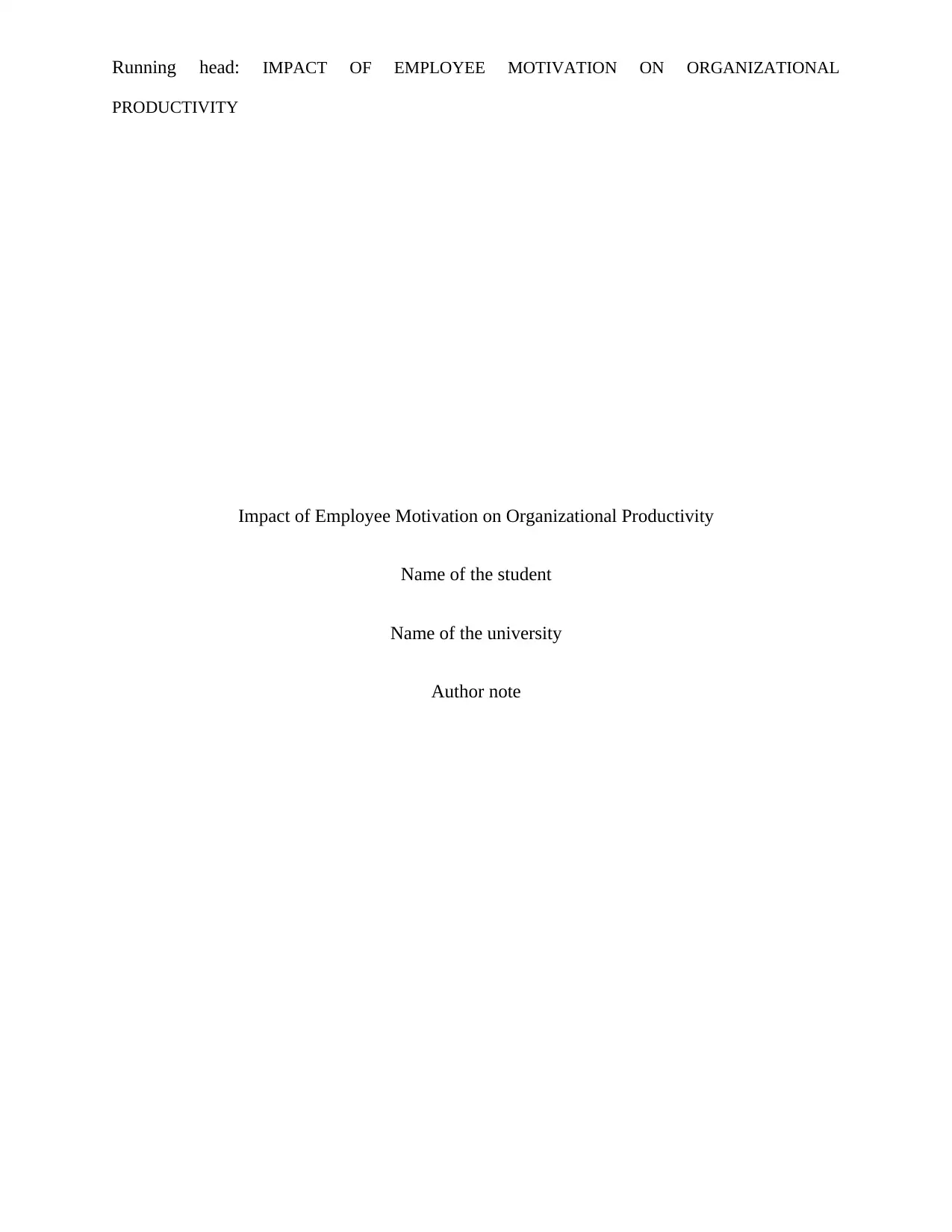
Running head: IMPACT OF EMPLOYEE MOTIVATION ON ORGANIZATIONAL
PRODUCTIVITY
Impact of Employee Motivation on Organizational Productivity
Name of the student
Name of the university
Author note
PRODUCTIVITY
Impact of Employee Motivation on Organizational Productivity
Name of the student
Name of the university
Author note
Paraphrase This Document
Need a fresh take? Get an instant paraphrase of this document with our AI Paraphraser
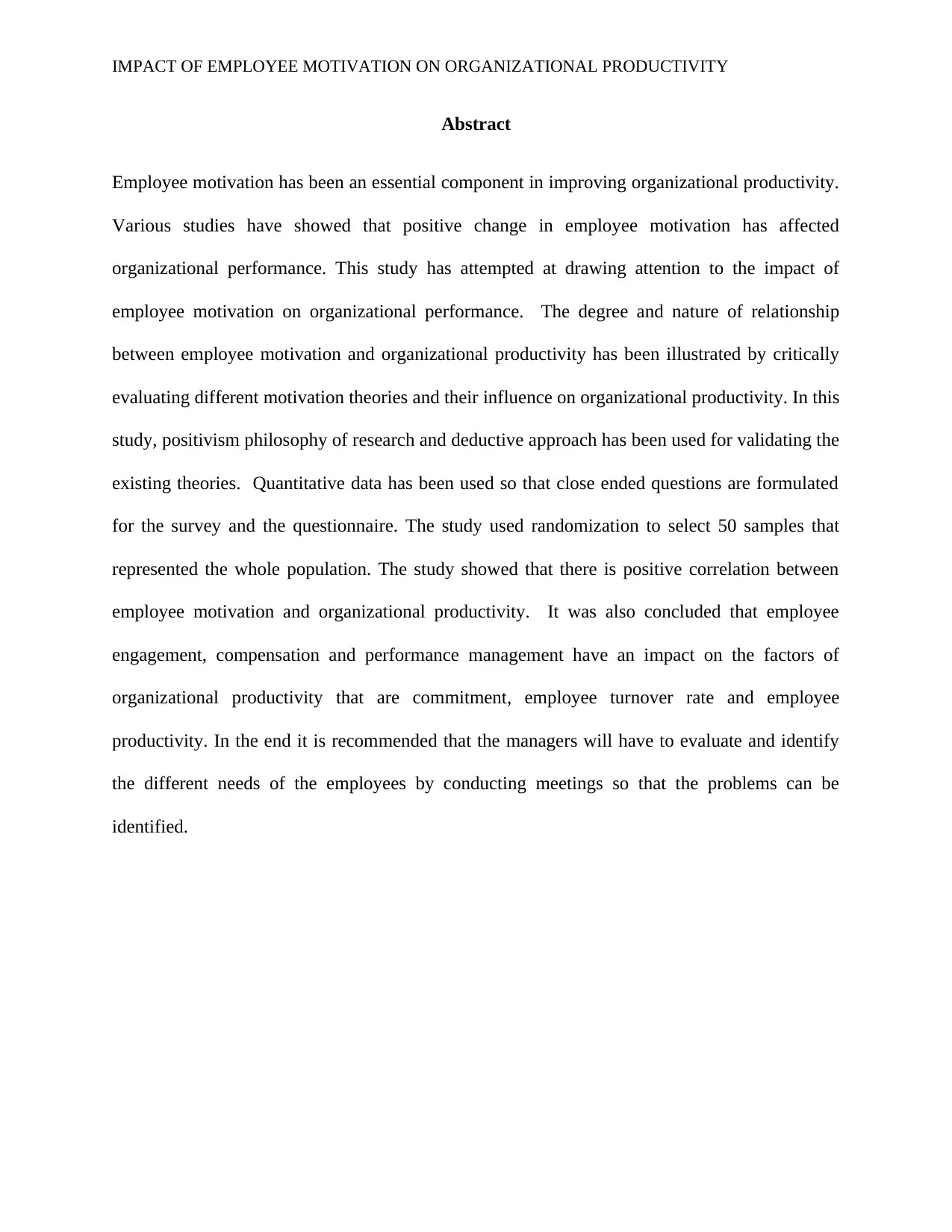
IMPACT OF EMPLOYEE MOTIVATION ON ORGANIZATIONAL PRODUCTIVITY
Abstract
Employee motivation has been an essential component in improving organizational productivity.
Various studies have showed that positive change in employee motivation has affected
organizational performance. This study has attempted at drawing attention to the impact of
employee motivation on organizational performance. The degree and nature of relationship
between employee motivation and organizational productivity has been illustrated by critically
evaluating different motivation theories and their influence on organizational productivity. In this
study, positivism philosophy of research and deductive approach has been used for validating the
existing theories. Quantitative data has been used so that close ended questions are formulated
for the survey and the questionnaire. The study used randomization to select 50 samples that
represented the whole population. The study showed that there is positive correlation between
employee motivation and organizational productivity. It was also concluded that employee
engagement, compensation and performance management have an impact on the factors of
organizational productivity that are commitment, employee turnover rate and employee
productivity. In the end it is recommended that the managers will have to evaluate and identify
the different needs of the employees by conducting meetings so that the problems can be
identified.
Abstract
Employee motivation has been an essential component in improving organizational productivity.
Various studies have showed that positive change in employee motivation has affected
organizational performance. This study has attempted at drawing attention to the impact of
employee motivation on organizational performance. The degree and nature of relationship
between employee motivation and organizational productivity has been illustrated by critically
evaluating different motivation theories and their influence on organizational productivity. In this
study, positivism philosophy of research and deductive approach has been used for validating the
existing theories. Quantitative data has been used so that close ended questions are formulated
for the survey and the questionnaire. The study used randomization to select 50 samples that
represented the whole population. The study showed that there is positive correlation between
employee motivation and organizational productivity. It was also concluded that employee
engagement, compensation and performance management have an impact on the factors of
organizational productivity that are commitment, employee turnover rate and employee
productivity. In the end it is recommended that the managers will have to evaluate and identify
the different needs of the employees by conducting meetings so that the problems can be
identified.
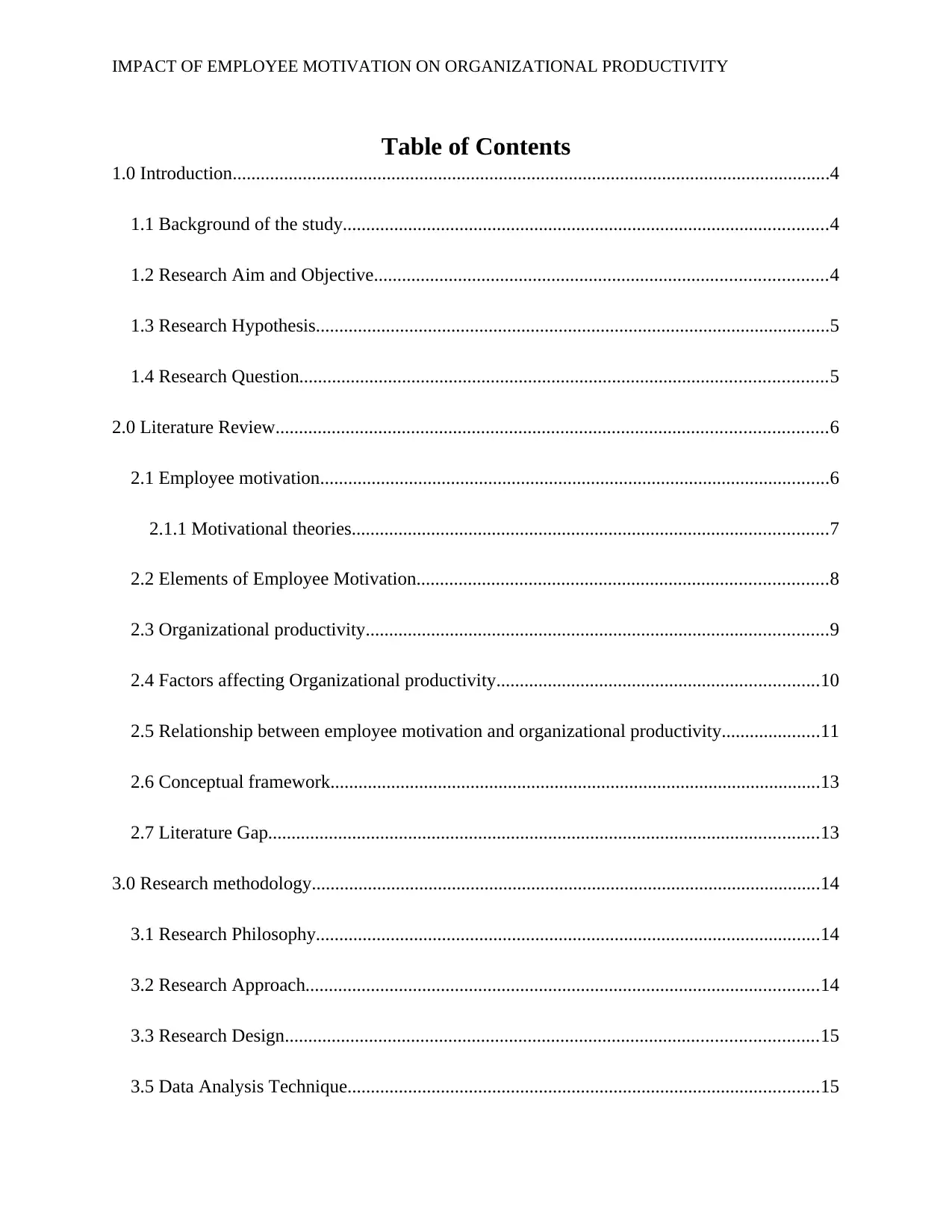
IMPACT OF EMPLOYEE MOTIVATION ON ORGANIZATIONAL PRODUCTIVITY
Table of Contents
1.0 Introduction................................................................................................................................4
1.1 Background of the study........................................................................................................4
1.2 Research Aim and Objective.................................................................................................4
1.3 Research Hypothesis..............................................................................................................5
1.4 Research Question.................................................................................................................5
2.0 Literature Review......................................................................................................................6
2.1 Employee motivation.............................................................................................................6
2.1.1 Motivational theories......................................................................................................7
2.2 Elements of Employee Motivation........................................................................................8
2.3 Organizational productivity...................................................................................................9
2.4 Factors affecting Organizational productivity.....................................................................10
2.5 Relationship between employee motivation and organizational productivity.....................11
2.6 Conceptual framework.........................................................................................................13
2.7 Literature Gap......................................................................................................................13
3.0 Research methodology.............................................................................................................14
3.1 Research Philosophy............................................................................................................14
3.2 Research Approach..............................................................................................................14
3.3 Research Design..................................................................................................................15
3.5 Data Analysis Technique.....................................................................................................15
Table of Contents
1.0 Introduction................................................................................................................................4
1.1 Background of the study........................................................................................................4
1.2 Research Aim and Objective.................................................................................................4
1.3 Research Hypothesis..............................................................................................................5
1.4 Research Question.................................................................................................................5
2.0 Literature Review......................................................................................................................6
2.1 Employee motivation.............................................................................................................6
2.1.1 Motivational theories......................................................................................................7
2.2 Elements of Employee Motivation........................................................................................8
2.3 Organizational productivity...................................................................................................9
2.4 Factors affecting Organizational productivity.....................................................................10
2.5 Relationship between employee motivation and organizational productivity.....................11
2.6 Conceptual framework.........................................................................................................13
2.7 Literature Gap......................................................................................................................13
3.0 Research methodology.............................................................................................................14
3.1 Research Philosophy............................................................................................................14
3.2 Research Approach..............................................................................................................14
3.3 Research Design..................................................................................................................15
3.5 Data Analysis Technique.....................................................................................................15
⊘ This is a preview!⊘
Do you want full access?
Subscribe today to unlock all pages.

Trusted by 1+ million students worldwide
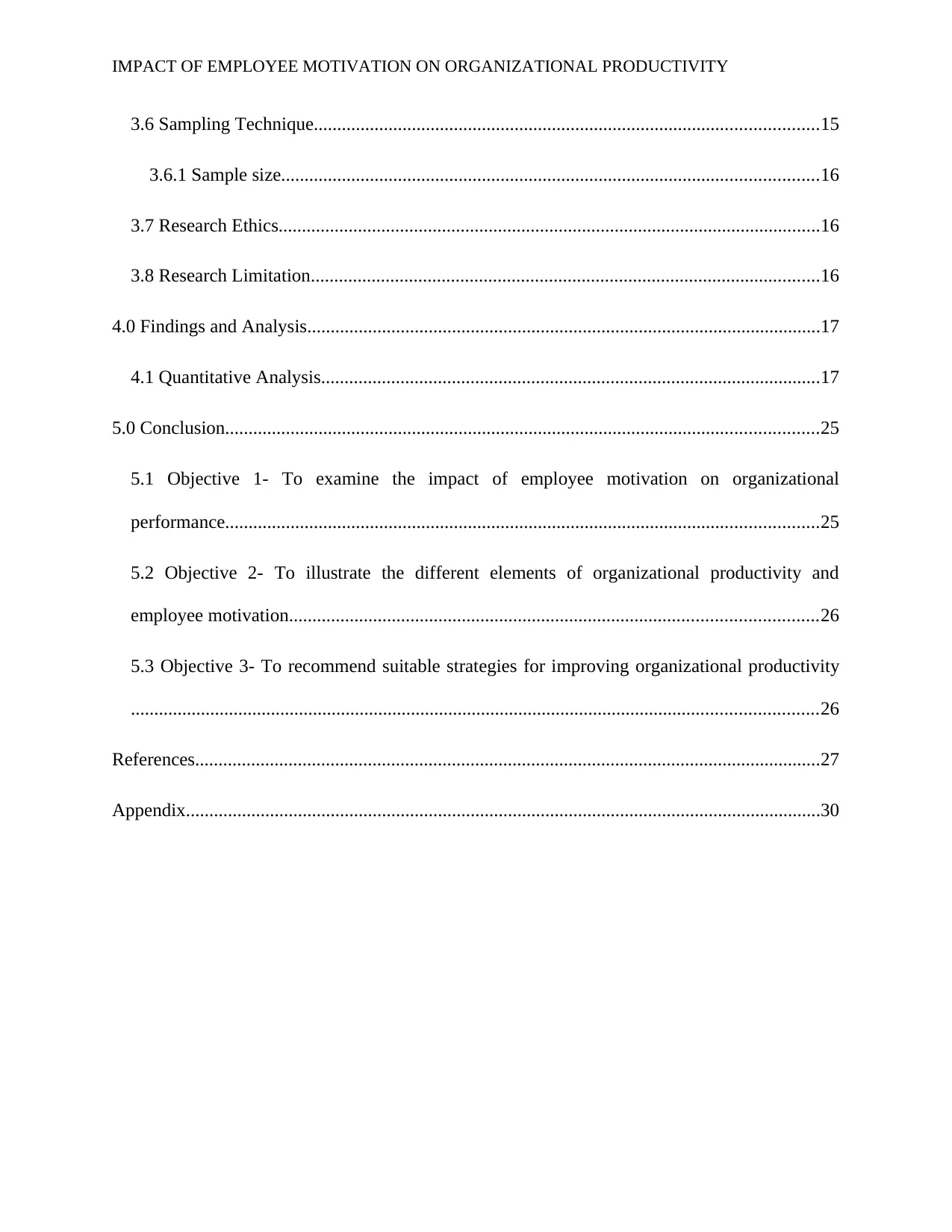
IMPACT OF EMPLOYEE MOTIVATION ON ORGANIZATIONAL PRODUCTIVITY
3.6 Sampling Technique............................................................................................................15
3.6.1 Sample size...................................................................................................................16
3.7 Research Ethics....................................................................................................................16
3.8 Research Limitation.............................................................................................................16
4.0 Findings and Analysis..............................................................................................................17
4.1 Quantitative Analysis...........................................................................................................17
5.0 Conclusion...............................................................................................................................25
5.1 Objective 1- To examine the impact of employee motivation on organizational
performance...............................................................................................................................25
5.2 Objective 2- To illustrate the different elements of organizational productivity and
employee motivation.................................................................................................................26
5.3 Objective 3- To recommend suitable strategies for improving organizational productivity
...................................................................................................................................................26
References......................................................................................................................................27
Appendix........................................................................................................................................30
3.6 Sampling Technique............................................................................................................15
3.6.1 Sample size...................................................................................................................16
3.7 Research Ethics....................................................................................................................16
3.8 Research Limitation.............................................................................................................16
4.0 Findings and Analysis..............................................................................................................17
4.1 Quantitative Analysis...........................................................................................................17
5.0 Conclusion...............................................................................................................................25
5.1 Objective 1- To examine the impact of employee motivation on organizational
performance...............................................................................................................................25
5.2 Objective 2- To illustrate the different elements of organizational productivity and
employee motivation.................................................................................................................26
5.3 Objective 3- To recommend suitable strategies for improving organizational productivity
...................................................................................................................................................26
References......................................................................................................................................27
Appendix........................................................................................................................................30
Paraphrase This Document
Need a fresh take? Get an instant paraphrase of this document with our AI Paraphraser
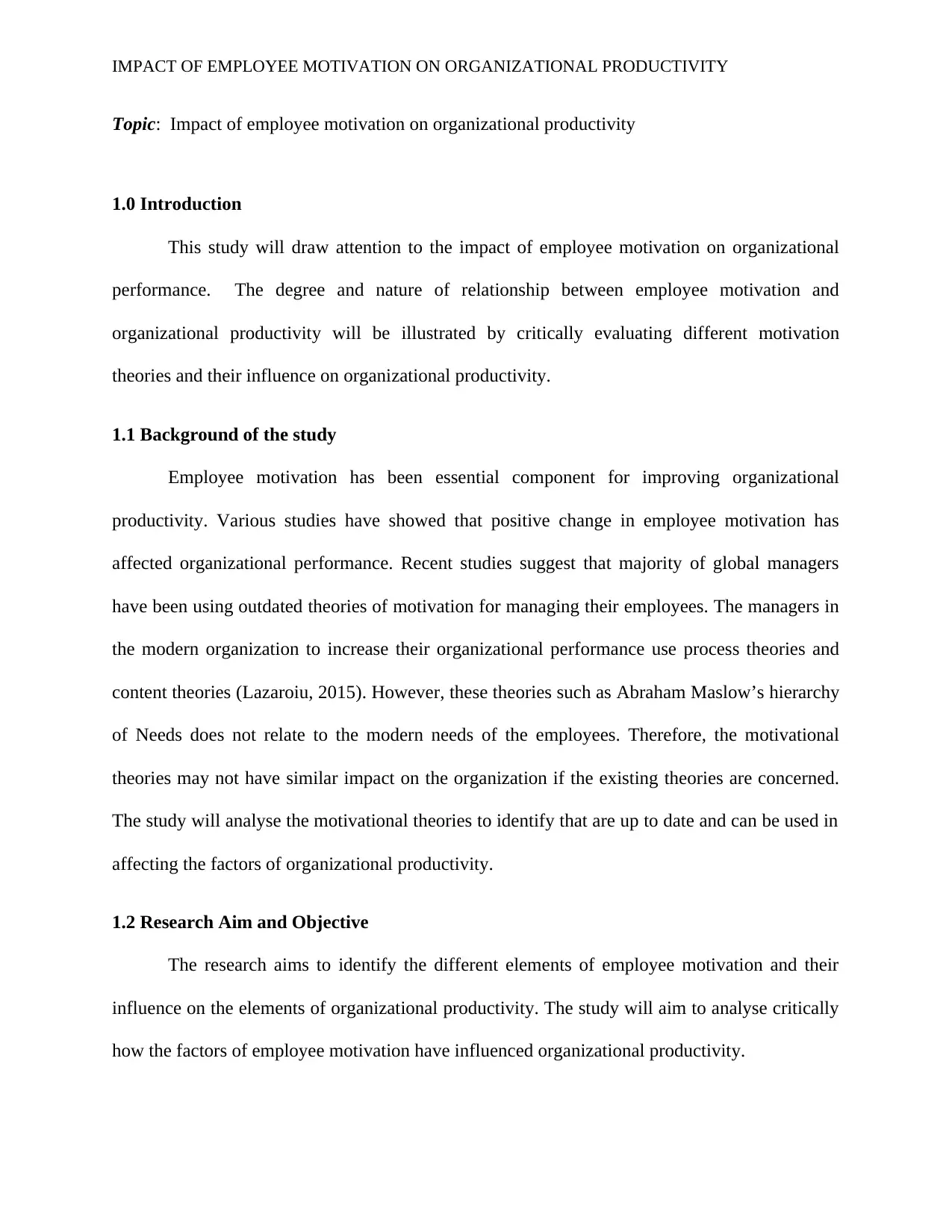
IMPACT OF EMPLOYEE MOTIVATION ON ORGANIZATIONAL PRODUCTIVITY
Topic: Impact of employee motivation on organizational productivity
1.0 Introduction
This study will draw attention to the impact of employee motivation on organizational
performance. The degree and nature of relationship between employee motivation and
organizational productivity will be illustrated by critically evaluating different motivation
theories and their influence on organizational productivity.
1.1 Background of the study
Employee motivation has been essential component for improving organizational
productivity. Various studies have showed that positive change in employee motivation has
affected organizational performance. Recent studies suggest that majority of global managers
have been using outdated theories of motivation for managing their employees. The managers in
the modern organization to increase their organizational performance use process theories and
content theories (Lazaroiu, 2015). However, these theories such as Abraham Maslow’s hierarchy
of Needs does not relate to the modern needs of the employees. Therefore, the motivational
theories may not have similar impact on the organization if the existing theories are concerned.
The study will analyse the motivational theories to identify that are up to date and can be used in
affecting the factors of organizational productivity.
1.2 Research Aim and Objective
The research aims to identify the different elements of employee motivation and their
influence on the elements of organizational productivity. The study will aim to analyse critically
how the factors of employee motivation have influenced organizational productivity.
Topic: Impact of employee motivation on organizational productivity
1.0 Introduction
This study will draw attention to the impact of employee motivation on organizational
performance. The degree and nature of relationship between employee motivation and
organizational productivity will be illustrated by critically evaluating different motivation
theories and their influence on organizational productivity.
1.1 Background of the study
Employee motivation has been essential component for improving organizational
productivity. Various studies have showed that positive change in employee motivation has
affected organizational performance. Recent studies suggest that majority of global managers
have been using outdated theories of motivation for managing their employees. The managers in
the modern organization to increase their organizational performance use process theories and
content theories (Lazaroiu, 2015). However, these theories such as Abraham Maslow’s hierarchy
of Needs does not relate to the modern needs of the employees. Therefore, the motivational
theories may not have similar impact on the organization if the existing theories are concerned.
The study will analyse the motivational theories to identify that are up to date and can be used in
affecting the factors of organizational productivity.
1.2 Research Aim and Objective
The research aims to identify the different elements of employee motivation and their
influence on the elements of organizational productivity. The study will aim to analyse critically
how the factors of employee motivation have influenced organizational productivity.
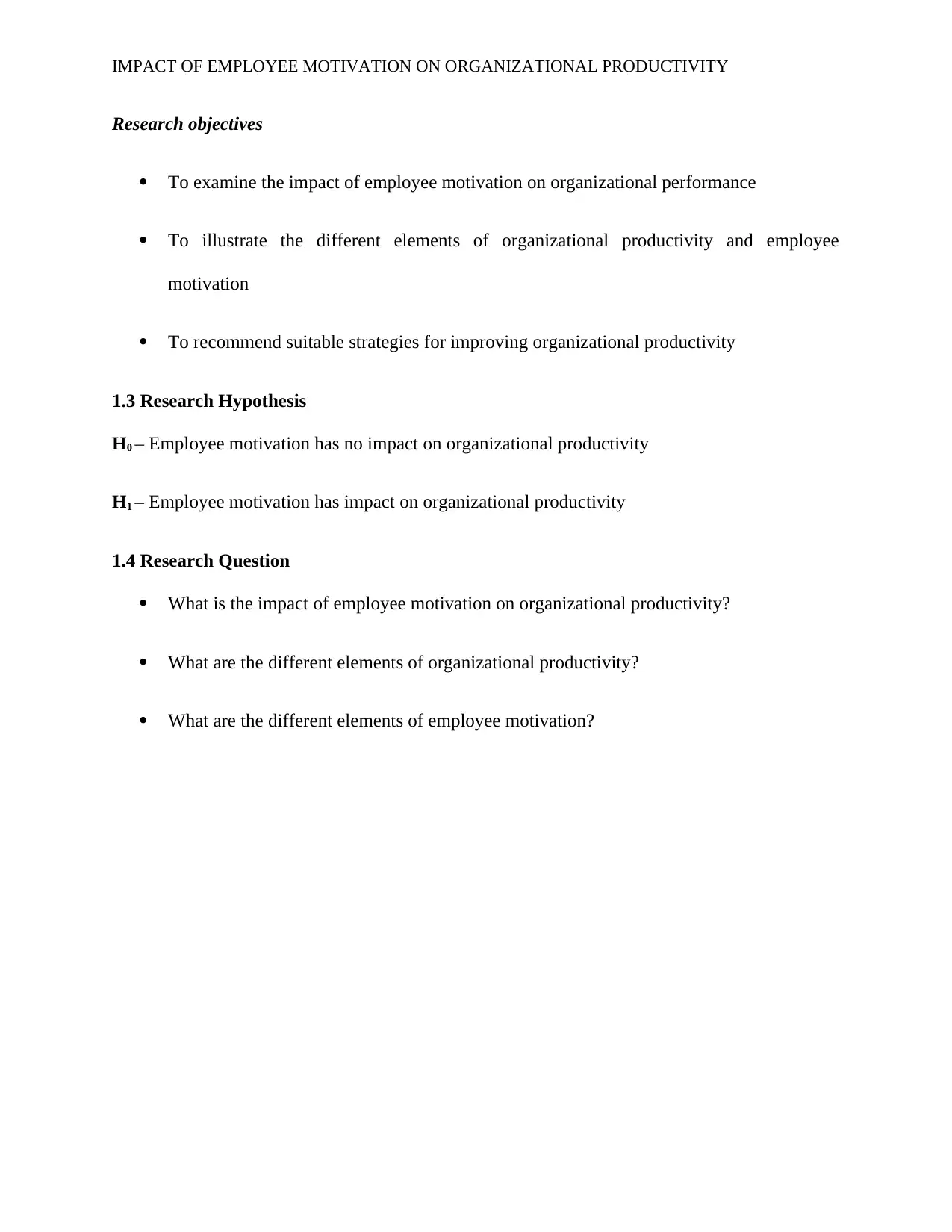
IMPACT OF EMPLOYEE MOTIVATION ON ORGANIZATIONAL PRODUCTIVITY
Research objectives
To examine the impact of employee motivation on organizational performance
To illustrate the different elements of organizational productivity and employee
motivation
To recommend suitable strategies for improving organizational productivity
1.3 Research Hypothesis
H0 – Employee motivation has no impact on organizational productivity
H1 – Employee motivation has impact on organizational productivity
1.4 Research Question
What is the impact of employee motivation on organizational productivity?
What are the different elements of organizational productivity?
What are the different elements of employee motivation?
Research objectives
To examine the impact of employee motivation on organizational performance
To illustrate the different elements of organizational productivity and employee
motivation
To recommend suitable strategies for improving organizational productivity
1.3 Research Hypothesis
H0 – Employee motivation has no impact on organizational productivity
H1 – Employee motivation has impact on organizational productivity
1.4 Research Question
What is the impact of employee motivation on organizational productivity?
What are the different elements of organizational productivity?
What are the different elements of employee motivation?
⊘ This is a preview!⊘
Do you want full access?
Subscribe today to unlock all pages.

Trusted by 1+ million students worldwide
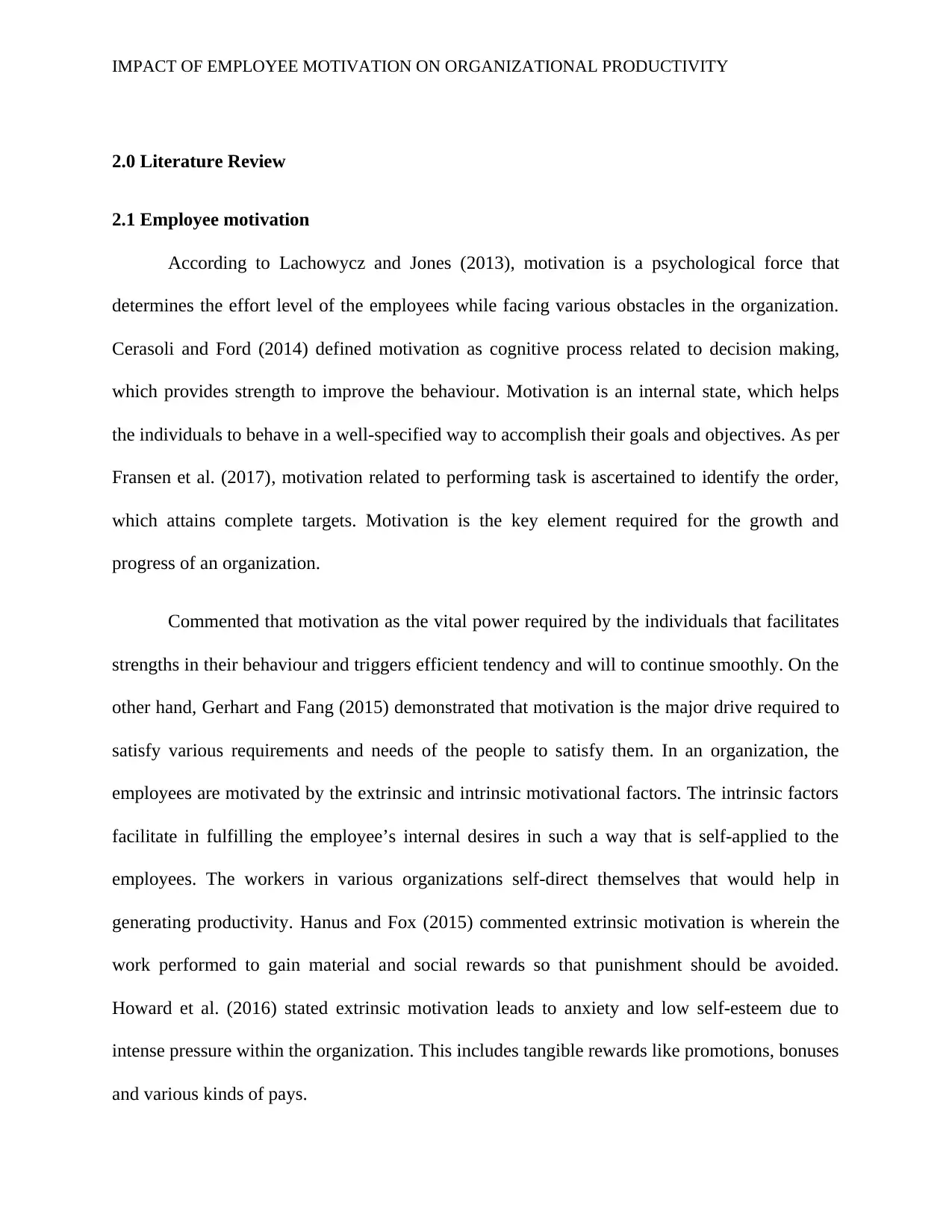
IMPACT OF EMPLOYEE MOTIVATION ON ORGANIZATIONAL PRODUCTIVITY
2.0 Literature Review
2.1 Employee motivation
According to Lachowycz and Jones (2013), motivation is a psychological force that
determines the effort level of the employees while facing various obstacles in the organization.
Cerasoli and Ford (2014) defined motivation as cognitive process related to decision making,
which provides strength to improve the behaviour. Motivation is an internal state, which helps
the individuals to behave in a well-specified way to accomplish their goals and objectives. As per
Fransen et al. (2017), motivation related to performing task is ascertained to identify the order,
which attains complete targets. Motivation is the key element required for the growth and
progress of an organization.
Commented that motivation as the vital power required by the individuals that facilitates
strengths in their behaviour and triggers efficient tendency and will to continue smoothly. On the
other hand, Gerhart and Fang (2015) demonstrated that motivation is the major drive required to
satisfy various requirements and needs of the people to satisfy them. In an organization, the
employees are motivated by the extrinsic and intrinsic motivational factors. The intrinsic factors
facilitate in fulfilling the employee’s internal desires in such a way that is self-applied to the
employees. The workers in various organizations self-direct themselves that would help in
generating productivity. Hanus and Fox (2015) commented extrinsic motivation is wherein the
work performed to gain material and social rewards so that punishment should be avoided.
Howard et al. (2016) stated extrinsic motivation leads to anxiety and low self-esteem due to
intense pressure within the organization. This includes tangible rewards like promotions, bonuses
and various kinds of pays.
2.0 Literature Review
2.1 Employee motivation
According to Lachowycz and Jones (2013), motivation is a psychological force that
determines the effort level of the employees while facing various obstacles in the organization.
Cerasoli and Ford (2014) defined motivation as cognitive process related to decision making,
which provides strength to improve the behaviour. Motivation is an internal state, which helps
the individuals to behave in a well-specified way to accomplish their goals and objectives. As per
Fransen et al. (2017), motivation related to performing task is ascertained to identify the order,
which attains complete targets. Motivation is the key element required for the growth and
progress of an organization.
Commented that motivation as the vital power required by the individuals that facilitates
strengths in their behaviour and triggers efficient tendency and will to continue smoothly. On the
other hand, Gerhart and Fang (2015) demonstrated that motivation is the major drive required to
satisfy various requirements and needs of the people to satisfy them. In an organization, the
employees are motivated by the extrinsic and intrinsic motivational factors. The intrinsic factors
facilitate in fulfilling the employee’s internal desires in such a way that is self-applied to the
employees. The workers in various organizations self-direct themselves that would help in
generating productivity. Hanus and Fox (2015) commented extrinsic motivation is wherein the
work performed to gain material and social rewards so that punishment should be avoided.
Howard et al. (2016) stated extrinsic motivation leads to anxiety and low self-esteem due to
intense pressure within the organization. This includes tangible rewards like promotions, bonuses
and various kinds of pays.
Paraphrase This Document
Need a fresh take? Get an instant paraphrase of this document with our AI Paraphraser
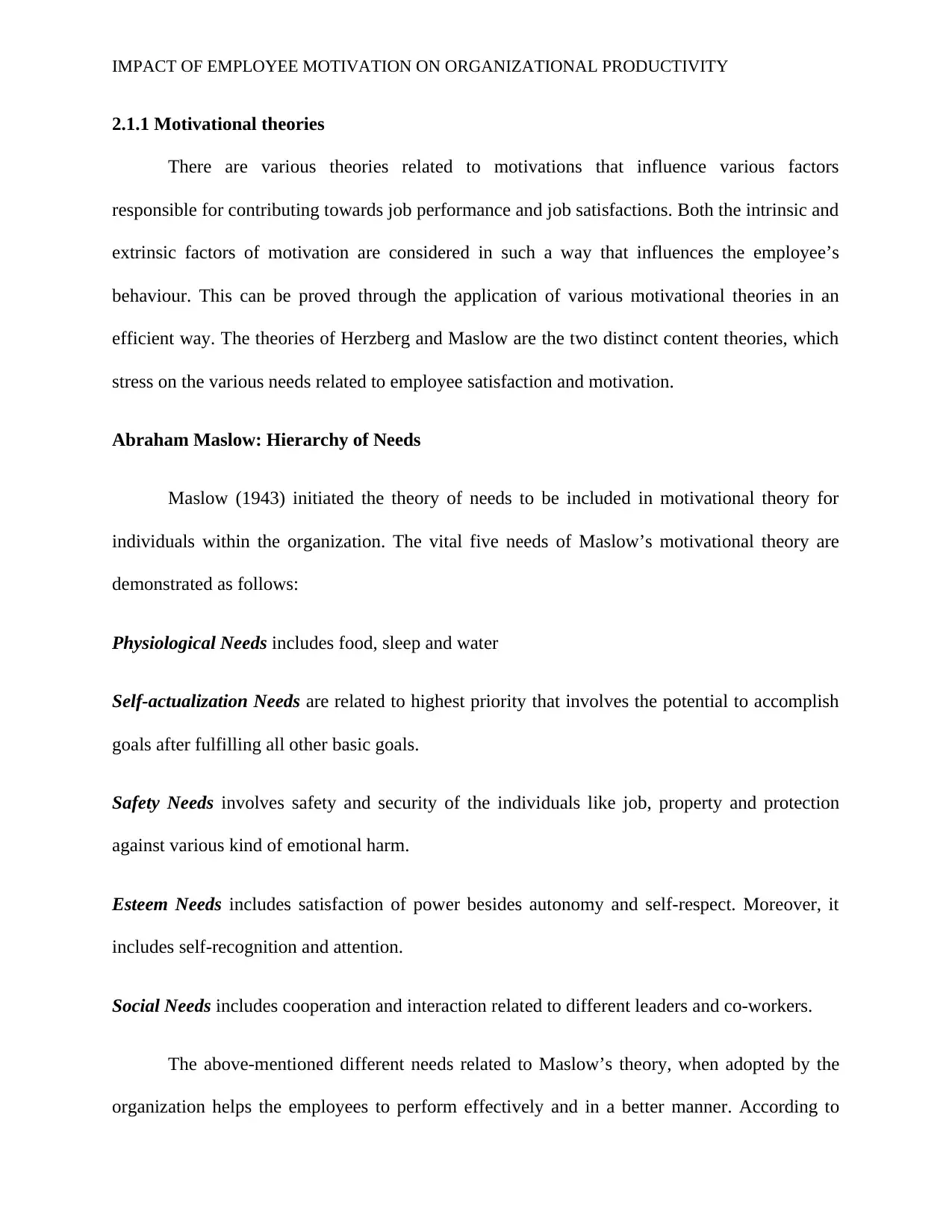
IMPACT OF EMPLOYEE MOTIVATION ON ORGANIZATIONAL PRODUCTIVITY
2.1.1 Motivational theories
There are various theories related to motivations that influence various factors
responsible for contributing towards job performance and job satisfactions. Both the intrinsic and
extrinsic factors of motivation are considered in such a way that influences the employee’s
behaviour. This can be proved through the application of various motivational theories in an
efficient way. The theories of Herzberg and Maslow are the two distinct content theories, which
stress on the various needs related to employee satisfaction and motivation.
Abraham Maslow: Hierarchy of Needs
Maslow (1943) initiated the theory of needs to be included in motivational theory for
individuals within the organization. The vital five needs of Maslow’s motivational theory are
demonstrated as follows:
Physiological Needs includes food, sleep and water
Self-actualization Needs are related to highest priority that involves the potential to accomplish
goals after fulfilling all other basic goals.
Safety Needs involves safety and security of the individuals like job, property and protection
against various kind of emotional harm.
Esteem Needs includes satisfaction of power besides autonomy and self-respect. Moreover, it
includes self-recognition and attention.
Social Needs includes cooperation and interaction related to different leaders and co-workers.
The above-mentioned different needs related to Maslow’s theory, when adopted by the
organization helps the employees to perform effectively and in a better manner. According to
2.1.1 Motivational theories
There are various theories related to motivations that influence various factors
responsible for contributing towards job performance and job satisfactions. Both the intrinsic and
extrinsic factors of motivation are considered in such a way that influences the employee’s
behaviour. This can be proved through the application of various motivational theories in an
efficient way. The theories of Herzberg and Maslow are the two distinct content theories, which
stress on the various needs related to employee satisfaction and motivation.
Abraham Maslow: Hierarchy of Needs
Maslow (1943) initiated the theory of needs to be included in motivational theory for
individuals within the organization. The vital five needs of Maslow’s motivational theory are
demonstrated as follows:
Physiological Needs includes food, sleep and water
Self-actualization Needs are related to highest priority that involves the potential to accomplish
goals after fulfilling all other basic goals.
Safety Needs involves safety and security of the individuals like job, property and protection
against various kind of emotional harm.
Esteem Needs includes satisfaction of power besides autonomy and self-respect. Moreover, it
includes self-recognition and attention.
Social Needs includes cooperation and interaction related to different leaders and co-workers.
The above-mentioned different needs related to Maslow’s theory, when adopted by the
organization helps the employees to perform effectively and in a better manner. According to
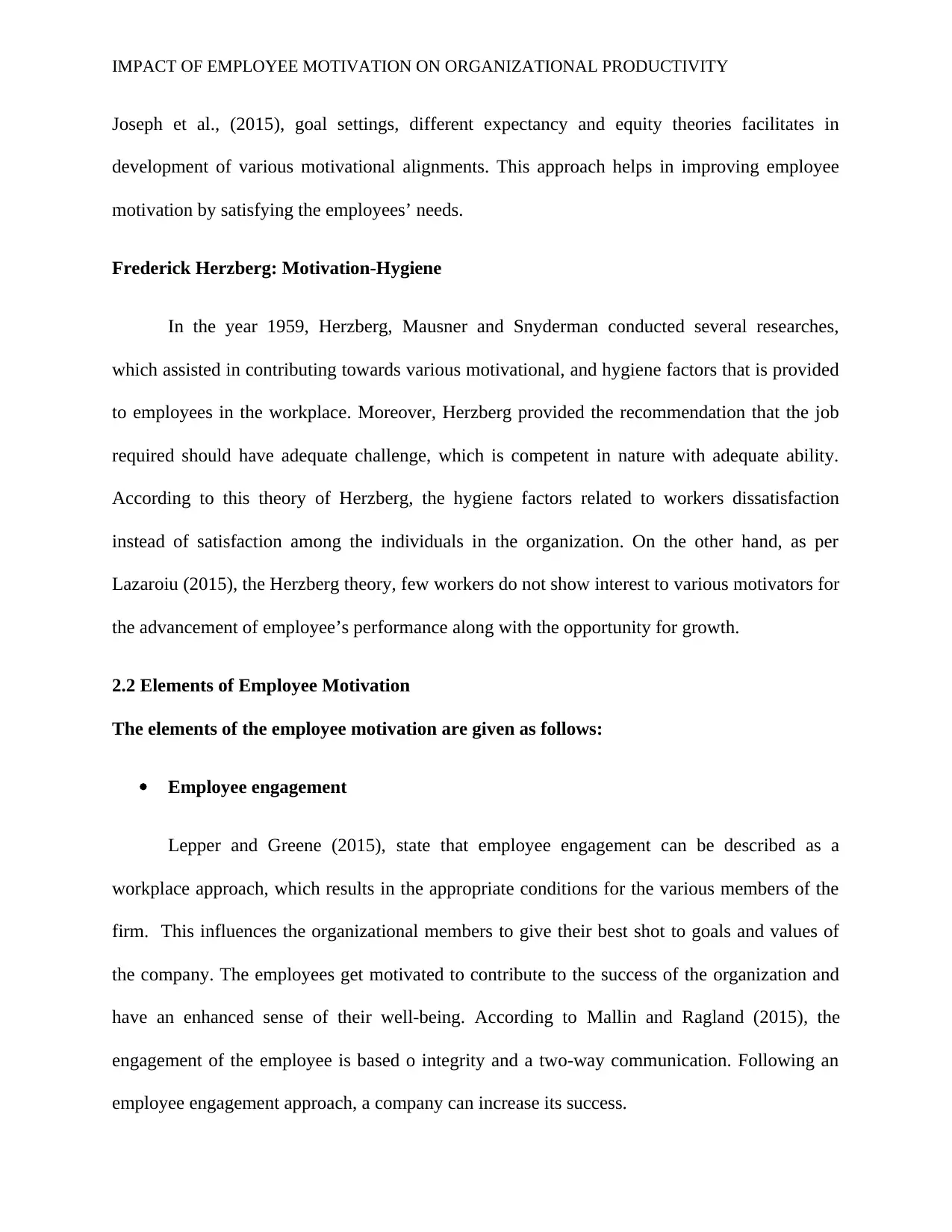
IMPACT OF EMPLOYEE MOTIVATION ON ORGANIZATIONAL PRODUCTIVITY
Joseph et al., (2015), goal settings, different expectancy and equity theories facilitates in
development of various motivational alignments. This approach helps in improving employee
motivation by satisfying the employees’ needs.
Frederick Herzberg: Motivation-Hygiene
In the year 1959, Herzberg, Mausner and Snyderman conducted several researches,
which assisted in contributing towards various motivational, and hygiene factors that is provided
to employees in the workplace. Moreover, Herzberg provided the recommendation that the job
required should have adequate challenge, which is competent in nature with adequate ability.
According to this theory of Herzberg, the hygiene factors related to workers dissatisfaction
instead of satisfaction among the individuals in the organization. On the other hand, as per
Lazaroiu (2015), the Herzberg theory, few workers do not show interest to various motivators for
the advancement of employee’s performance along with the opportunity for growth.
2.2 Elements of Employee Motivation
The elements of the employee motivation are given as follows:
Employee engagement
Lepper and Greene (2015), state that employee engagement can be described as a
workplace approach, which results in the appropriate conditions for the various members of the
firm. This influences the organizational members to give their best shot to goals and values of
the company. The employees get motivated to contribute to the success of the organization and
have an enhanced sense of their well-being. According to Mallin and Ragland (2015), the
engagement of the employee is based o integrity and a two-way communication. Following an
employee engagement approach, a company can increase its success.
Joseph et al., (2015), goal settings, different expectancy and equity theories facilitates in
development of various motivational alignments. This approach helps in improving employee
motivation by satisfying the employees’ needs.
Frederick Herzberg: Motivation-Hygiene
In the year 1959, Herzberg, Mausner and Snyderman conducted several researches,
which assisted in contributing towards various motivational, and hygiene factors that is provided
to employees in the workplace. Moreover, Herzberg provided the recommendation that the job
required should have adequate challenge, which is competent in nature with adequate ability.
According to this theory of Herzberg, the hygiene factors related to workers dissatisfaction
instead of satisfaction among the individuals in the organization. On the other hand, as per
Lazaroiu (2015), the Herzberg theory, few workers do not show interest to various motivators for
the advancement of employee’s performance along with the opportunity for growth.
2.2 Elements of Employee Motivation
The elements of the employee motivation are given as follows:
Employee engagement
Lepper and Greene (2015), state that employee engagement can be described as a
workplace approach, which results in the appropriate conditions for the various members of the
firm. This influences the organizational members to give their best shot to goals and values of
the company. The employees get motivated to contribute to the success of the organization and
have an enhanced sense of their well-being. According to Mallin and Ragland (2015), the
engagement of the employee is based o integrity and a two-way communication. Following an
employee engagement approach, a company can increase its success.
⊘ This is a preview!⊘
Do you want full access?
Subscribe today to unlock all pages.

Trusted by 1+ million students worldwide
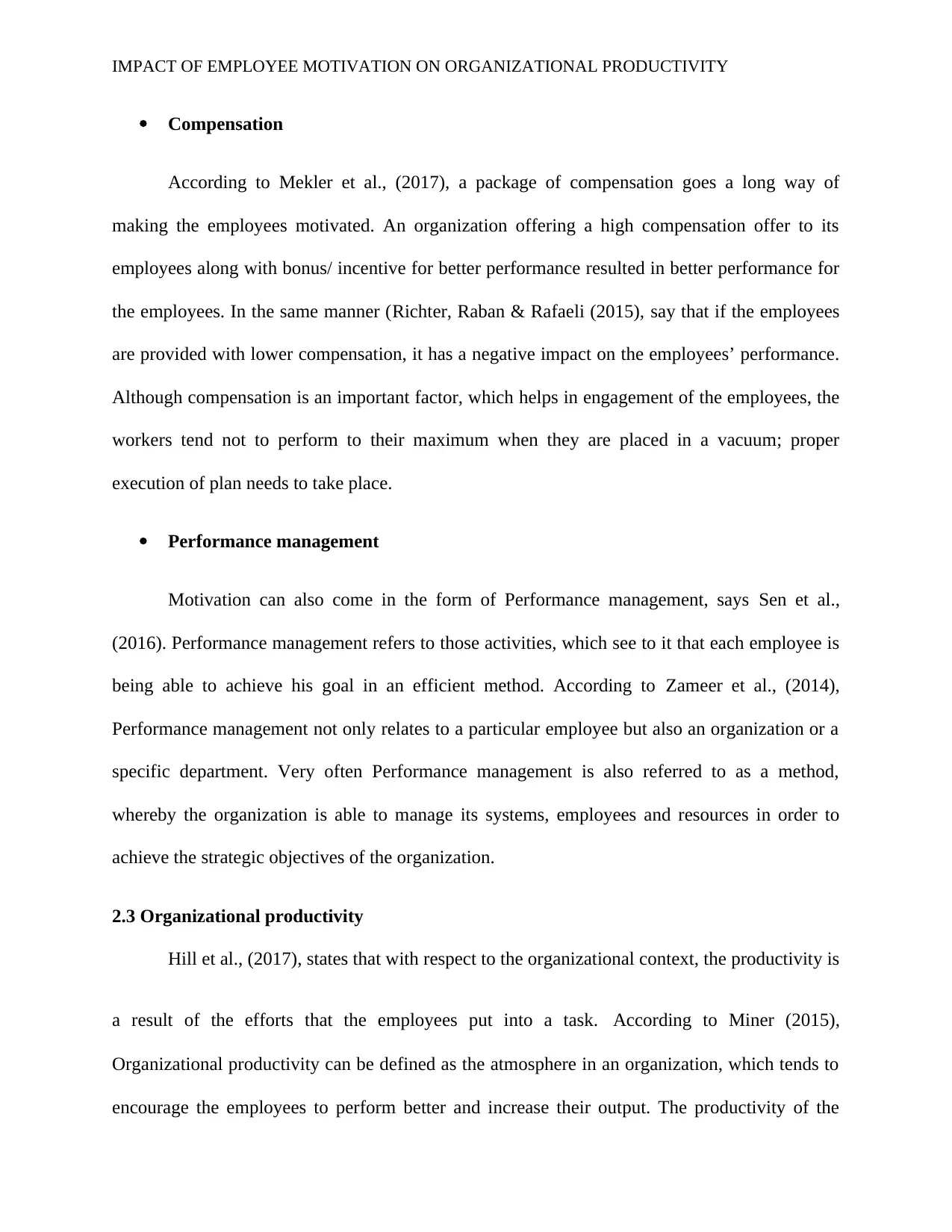
IMPACT OF EMPLOYEE MOTIVATION ON ORGANIZATIONAL PRODUCTIVITY
Compensation
According to Mekler et al., (2017), a package of compensation goes a long way of
making the employees motivated. An organization offering a high compensation offer to its
employees along with bonus/ incentive for better performance resulted in better performance for
the employees. In the same manner (Richter, Raban & Rafaeli (2015), say that if the employees
are provided with lower compensation, it has a negative impact on the employees’ performance.
Although compensation is an important factor, which helps in engagement of the employees, the
workers tend not to perform to their maximum when they are placed in a vacuum; proper
execution of plan needs to take place.
Performance management
Motivation can also come in the form of Performance management, says Sen et al.,
(2016). Performance management refers to those activities, which see to it that each employee is
being able to achieve his goal in an efficient method. According to Zameer et al., (2014),
Performance management not only relates to a particular employee but also an organization or a
specific department. Very often Performance management is also referred to as a method,
whereby the organization is able to manage its systems, employees and resources in order to
achieve the strategic objectives of the organization.
2.3 Organizational productivity
Hill et al., (2017), states that with respect to the organizational context, the productivity is
a result of the efforts that the employees put into a task. According to Miner (2015),
Organizational productivity can be defined as the atmosphere in an organization, which tends to
encourage the employees to perform better and increase their output. The productivity of the
Compensation
According to Mekler et al., (2017), a package of compensation goes a long way of
making the employees motivated. An organization offering a high compensation offer to its
employees along with bonus/ incentive for better performance resulted in better performance for
the employees. In the same manner (Richter, Raban & Rafaeli (2015), say that if the employees
are provided with lower compensation, it has a negative impact on the employees’ performance.
Although compensation is an important factor, which helps in engagement of the employees, the
workers tend not to perform to their maximum when they are placed in a vacuum; proper
execution of plan needs to take place.
Performance management
Motivation can also come in the form of Performance management, says Sen et al.,
(2016). Performance management refers to those activities, which see to it that each employee is
being able to achieve his goal in an efficient method. According to Zameer et al., (2014),
Performance management not only relates to a particular employee but also an organization or a
specific department. Very often Performance management is also referred to as a method,
whereby the organization is able to manage its systems, employees and resources in order to
achieve the strategic objectives of the organization.
2.3 Organizational productivity
Hill et al., (2017), states that with respect to the organizational context, the productivity is
a result of the efforts that the employees put into a task. According to Miner (2015),
Organizational productivity can be defined as the atmosphere in an organization, which tends to
encourage the employees to perform better and increase their output. The productivity of the
Paraphrase This Document
Need a fresh take? Get an instant paraphrase of this document with our AI Paraphraser
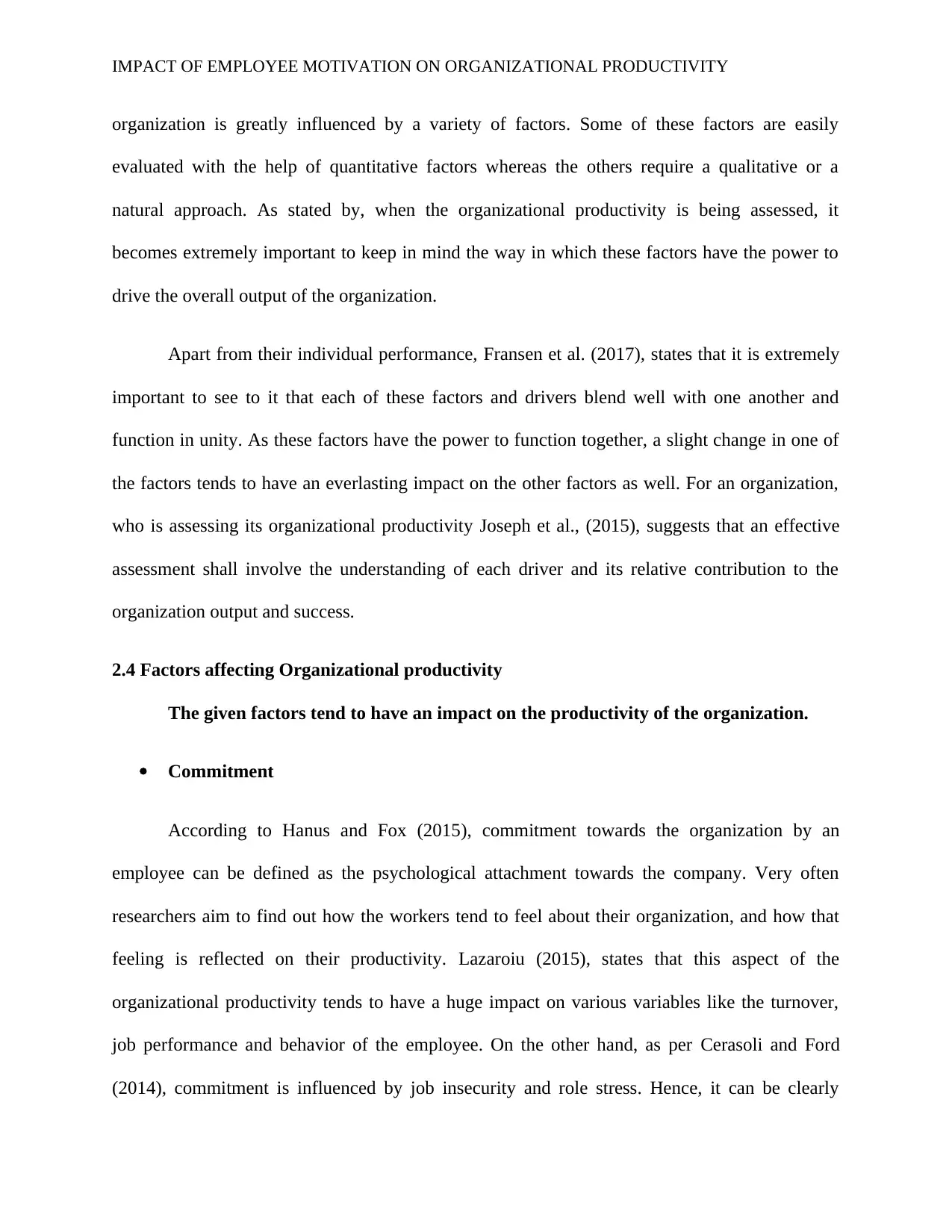
IMPACT OF EMPLOYEE MOTIVATION ON ORGANIZATIONAL PRODUCTIVITY
organization is greatly influenced by a variety of factors. Some of these factors are easily
evaluated with the help of quantitative factors whereas the others require a qualitative or a
natural approach. As stated by, when the organizational productivity is being assessed, it
becomes extremely important to keep in mind the way in which these factors have the power to
drive the overall output of the organization.
Apart from their individual performance, Fransen et al. (2017), states that it is extremely
important to see to it that each of these factors and drivers blend well with one another and
function in unity. As these factors have the power to function together, a slight change in one of
the factors tends to have an everlasting impact on the other factors as well. For an organization,
who is assessing its organizational productivity Joseph et al., (2015), suggests that an effective
assessment shall involve the understanding of each driver and its relative contribution to the
organization output and success.
2.4 Factors affecting Organizational productivity
The given factors tend to have an impact on the productivity of the organization.
Commitment
According to Hanus and Fox (2015), commitment towards the organization by an
employee can be defined as the psychological attachment towards the company. Very often
researchers aim to find out how the workers tend to feel about their organization, and how that
feeling is reflected on their productivity. Lazaroiu (2015), states that this aspect of the
organizational productivity tends to have a huge impact on various variables like the turnover,
job performance and behavior of the employee. On the other hand, as per Cerasoli and Ford
(2014), commitment is influenced by job insecurity and role stress. Hence, it can be clearly
organization is greatly influenced by a variety of factors. Some of these factors are easily
evaluated with the help of quantitative factors whereas the others require a qualitative or a
natural approach. As stated by, when the organizational productivity is being assessed, it
becomes extremely important to keep in mind the way in which these factors have the power to
drive the overall output of the organization.
Apart from their individual performance, Fransen et al. (2017), states that it is extremely
important to see to it that each of these factors and drivers blend well with one another and
function in unity. As these factors have the power to function together, a slight change in one of
the factors tends to have an everlasting impact on the other factors as well. For an organization,
who is assessing its organizational productivity Joseph et al., (2015), suggests that an effective
assessment shall involve the understanding of each driver and its relative contribution to the
organization output and success.
2.4 Factors affecting Organizational productivity
The given factors tend to have an impact on the productivity of the organization.
Commitment
According to Hanus and Fox (2015), commitment towards the organization by an
employee can be defined as the psychological attachment towards the company. Very often
researchers aim to find out how the workers tend to feel about their organization, and how that
feeling is reflected on their productivity. Lazaroiu (2015), states that this aspect of the
organizational productivity tends to have a huge impact on various variables like the turnover,
job performance and behavior of the employee. On the other hand, as per Cerasoli and Ford
(2014), commitment is influenced by job insecurity and role stress. Hence, it can be clearly
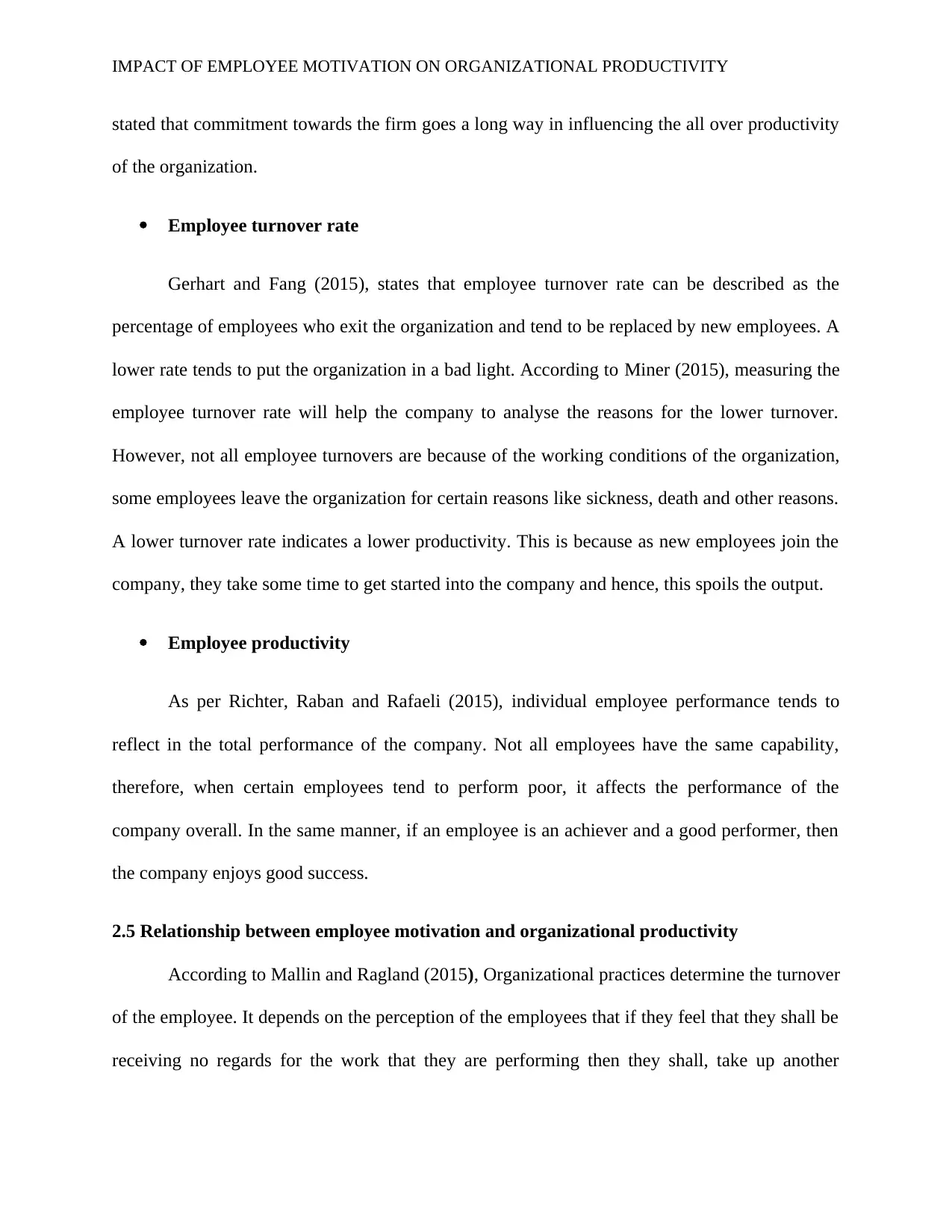
IMPACT OF EMPLOYEE MOTIVATION ON ORGANIZATIONAL PRODUCTIVITY
stated that commitment towards the firm goes a long way in influencing the all over productivity
of the organization.
Employee turnover rate
Gerhart and Fang (2015), states that employee turnover rate can be described as the
percentage of employees who exit the organization and tend to be replaced by new employees. A
lower rate tends to put the organization in a bad light. According to Miner (2015), measuring the
employee turnover rate will help the company to analyse the reasons for the lower turnover.
However, not all employee turnovers are because of the working conditions of the organization,
some employees leave the organization for certain reasons like sickness, death and other reasons.
A lower turnover rate indicates a lower productivity. This is because as new employees join the
company, they take some time to get started into the company and hence, this spoils the output.
Employee productivity
As per Richter, Raban and Rafaeli (2015), individual employee performance tends to
reflect in the total performance of the company. Not all employees have the same capability,
therefore, when certain employees tend to perform poor, it affects the performance of the
company overall. In the same manner, if an employee is an achiever and a good performer, then
the company enjoys good success.
2.5 Relationship between employee motivation and organizational productivity
According to Mallin and Ragland (2015), Organizational practices determine the turnover
of the employee. It depends on the perception of the employees that if they feel that they shall be
receiving no regards for the work that they are performing then they shall, take up another
stated that commitment towards the firm goes a long way in influencing the all over productivity
of the organization.
Employee turnover rate
Gerhart and Fang (2015), states that employee turnover rate can be described as the
percentage of employees who exit the organization and tend to be replaced by new employees. A
lower rate tends to put the organization in a bad light. According to Miner (2015), measuring the
employee turnover rate will help the company to analyse the reasons for the lower turnover.
However, not all employee turnovers are because of the working conditions of the organization,
some employees leave the organization for certain reasons like sickness, death and other reasons.
A lower turnover rate indicates a lower productivity. This is because as new employees join the
company, they take some time to get started into the company and hence, this spoils the output.
Employee productivity
As per Richter, Raban and Rafaeli (2015), individual employee performance tends to
reflect in the total performance of the company. Not all employees have the same capability,
therefore, when certain employees tend to perform poor, it affects the performance of the
company overall. In the same manner, if an employee is an achiever and a good performer, then
the company enjoys good success.
2.5 Relationship between employee motivation and organizational productivity
According to Mallin and Ragland (2015), Organizational practices determine the turnover
of the employee. It depends on the perception of the employees that if they feel that they shall be
receiving no regards for the work that they are performing then they shall, take up another
⊘ This is a preview!⊘
Do you want full access?
Subscribe today to unlock all pages.

Trusted by 1+ million students worldwide
1 out of 32
Related Documents
Your All-in-One AI-Powered Toolkit for Academic Success.
+13062052269
info@desklib.com
Available 24*7 on WhatsApp / Email
![[object Object]](/_next/static/media/star-bottom.7253800d.svg)
Unlock your academic potential
Copyright © 2020–2025 A2Z Services. All Rights Reserved. Developed and managed by ZUCOL.





